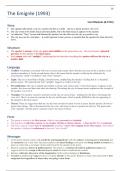16
The Emigrée (1993)
Carol Rumens (b.1944)
Story
• The speaker talks about a city in a country she left as a child – she has a purely positive view of it.
• The city seems to be under attack and unreachable, but in the third stanza it appears to the speaker.
• An unknown “They” accuse and threaten the speaker, but she stills sees the city in a positive way.
• The city may not be a real place – it could represent a time, person, or emotion that the speaker has been forced to
leave.
Structure
• The speaker’s memory of the city grows and solidifies as the poem moves on – the city becomes a physical
presence for the speaker in the final stanza.
• Each stanza ends with “sunlight”, reinforcing the fact that after everything the speaker still sees the city in a
positive light.
Language
• Conflict: Vocabulary associated with war, invasion and tyranny shows that the city may not be as perfect as the
speaker remembers it. In the second stanza, there’s the sense that the speaker is defying the authorities by
accessing her “child’s vocabulary” that’s been “banned”.
• Light: The city is described in bright, colourful terms, emphasising the speaker’s feeling that it’s a beautiful,
positive place. The repeated link with “sunlight” suggests a vitality to the city.
• Personification: The city is initially personified as being “sick with tyrants”. In the final stanza, it appears to the
speaker, lies down and then later takes her dancing. Describing the city in human terms emphasises the strength of
the speaker’s love for it.
• Nostalgia: The speaker’s positive memories of the city are unwavering – nothing else she hears will change her
view of it. There’s a sense of yearning for the city and the past, which is partly fulfilled by the city appearing to
the speaker in the final stanza.
• Threat: There are suggestions that the city has been invaded or taken over by a tyrant, but the speaker chooses to
ignore these things. She is threatened in her new city, and seems to have to protect her old city. The poem ends
with “sunlight”, but this doesn’t entirely remove the sense of threat.
Form
• The poem is written in the first person, which is more personal and relatable.
• The poem has 3 eight-line stanzas but no regular rhythm or rhyme scheme – it does not fit, like an emigrant.
• The first 2 stanzas contain lots of enjambment, but there’s more end stopping in the final stanza. This reflects
the speaker’s feeling of confinement in her new “city of walls”.
Messages
• In this poem, Rumens deals with sensitivity and imaginatively with the sadness of leaving one’s homeland and
the memories one is left with. The poem explores the mixed feelings associated with being unable to return to a
place or a time that is no longer clearly understood by the speaker in the poem.
• Rumens condemns abuses of political power. Her poem is a criticism of modern, political tyranny and
suggests that in fact escape is the best way to resist this kind of authoritarian control.
• Rumens celebrates the power of the imagination whilst acknowledging its limitations.
• Location is deliberately vague (in fact it’s entirely absent) in this poem; Rumens is much more interested in how
emigrants feel regardless of where they are going / come from.




